No.7 No.7
WE ARE MISSOURI
MISSOURI IS A DESIGN AND CREATIVE AGENCY.
WE CREATE MULTI-DIMENSIONAL BRAND WORLDS THAT HAVE THE POWER TO MOTIVATE AND MOVE YOU. WHETHER ON PACK, ON SHELF, IN BAR, AT HOME OR ONLINE, WE UNDERSTAND HOW THROUGH INSIGHTFUL AND EMOTIVE DESIGN AND COMMUNICATION WE CAN CREATE IMPACT WHERE IT MATTERS MOST. WE ARE UNBOUND BY DISCIPLINE AND WORK ACROSS CHANNELS, WE CAN DELIVER MORE CONNECTED AND COMPELLING EXPERIENCES FOR CONSUMERS AND TANGIBLE BUSINESS RESULTS FOR OUR CLIENTS. WE BELIEVE IN CREATING AWARD WINNING WORK THAT WORKS.
LET US SHOW YOU.
THE SERIOUS BUSINESS OF PLEASURE


published by WWW.MISSOURI-CREATIVE.COM Missouri Creative 7.02 The Tea Building 56 Shoreditch High Street London, E1 6JJ United Kingdom P: +44 (0)207 749 2605
HELLO,
WELCOME TO THE SEVENTH EDITION OF SHOW ME.
This issue is focused around ‘Pleasure’ and its evolving meaning - pain and pleasure are intertwined; this link is deeply rooted in our biology.
As consumer behaviours shift and marketing restrictions come into play, brands will need to find new and innovative ways to engage consumers.
In the first part of this issue, we investigate how consumers’ relationship with pleasure has changed, identifying key trends and the opportunities they present to brands in categories such as food, drink, and travel.
In the second part, we deep dive into two categories highly associated with pleasure, food and beverages, to understand how the changes in HFSS (high fat, salt and sugar) advertising will affect F&B communications. Here we explore how brands can reimagine their portfolio, positioning, product, and packaging to remain relevant with consumers and turn marketing restriction into opportunity.
In line with this issue’s focus on pleasure, we also feature an interview with TUI’s Global Brand Lead, Christian Torres, and our ‘What To Do’ list on the island of pleasure: Ibiza.
We hope that you take as much pleasure from reading this, as we’ve had putting it together for you.
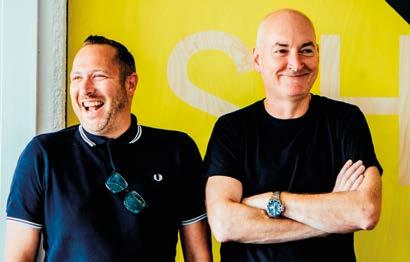
CONTENTS Stuart Wood stuart.wood@missouri-creative.com founding partner founding partner paul.brennan@missouri-creative.com
Brennan INTERVIEWS
PLEASURE IN PROGRESS MAKING
SHOW ME
Paul
FEATURED WORK FEATURES
LESS MEAN MORE
CHRISTIAN TORRES, GLOBAL BRAND LEAD TUI AVION - CREATING ELEVATED EXPERIENCES AT ICONIC BEACH DESTINATIONS SHOW ME IBIZA
PLEASURE IN PROGRESS
OUR CHANGING RELATIONSHIP WITH PLEASURE AND THE ANTIDOTE TO THE DOPAMINE DEFICIT

THE DOPAMINE DEFICIT
There’s no denying that it was a painful period for everyone. But pain and pleasure are intertwined; this link is deeply rooted in our biology.
For a start, the nervous system releases endorphins as a way of blocking pain. This endorphin activity leads to an increase in the production of dopamine, a neurotransmitter that plays a crucial role in how we experience pleasure.
Therefore, after a year of pain, it’s only natural that we now eagerly anticipated pleasure.
Our collective dopamine deficit was palpable. The world was in need of a good time.
HISTORY REPEATING?
It was just over 100 years ago that the world finally started to recover from 1918-20 Spanish Flu; one of history’s deadliest epidemics. This was quickly followed up by one of history’s deadliest wars, WW1. That prolonged period of hardship was the main cause of some major shifts in consumer behaviour. One of these being the embrace of freedom, which ultimately triggered a new era of rampant consumerism, a thriving music, art, and fashion scene, and an unashamed era of self-gratification known as the Roaring 20’s.
Not long after we started to come out of our homes after a long Winter in self-isolation, the parallels between what happened then and what was happening became clear.
Needless to say, people were more than ready to leave the pandemic behind. And as soon as our governments started to remove the social constraints, consumption levels picked up to get the world going once again.
Want proof? According to The British Retail Consortium, UK consumers splashed the cash when lockdown eased, leading to a total value of sales in May 2021 that was 10% higher than in May 2019; before we even heard about COVID-19. (Source: Bloomberg)
And as we came out the other side, we saw two very different social realities emerge.
In the first, a significant part of our society were actively rejecting any constraint to their personal freedom –enough is enough. In the other, there was a cohort for whom lockdown created a permanent shift in behaviour, causing them to hold onto newly acquired habits.
All of a sudden there was a big split in the market between hedonistic and restrained consumer behaviour. Below, you’ll find four key insights – two for each consumer type – and what your brand can to do to win their custom and their loyalty.
THE SERIOUS BUSINESS OF PLEASURE 1
There was no shortage of chaotic headlines at the height of the pandemic.
So, after a year of heightened anxiety and suffocating restrictions, the desire to let loose was widespread. As a result, many consumers are keen to indulge in instant gratification without giving too much thought to the implications of their decisions.
For many, pre-pandemic priorities such as sustainability and diversity took a back seat. Consumers want to shake off, at least temporarily, worries and responsibilities.
In fact, there were signs of that happening even at peak of the pandemic.
Consumer spending in August 2021 in pubs, bars and clubs rose by
In England, six million fewer people volunteered to support neighbours during the 2nd lockdown compared with the 1st; a decline of 33%, despite the fact that the level of acute loneliness had reached a new record high at that time. (Source: The Telegraph)
Once restrictions were finally lifted, it was Adios! to fakeaways and Zoom parties and Hola! to nightclubs in Ibiza. They want to escape. And when they do, they don’t want to stress about anything, least of all money.
In fact, consumer spending in August 2021 in pubs, bars and clubs have risen by 43.4% compared to the same month in 2019. (Source: Barclaycard)
43.3%

compared to the same month in 2019.
(Source: Barclaycard)
Opportunity:
Facilitate consumers to escape from the worries and responsibilities of the real world. They want to indulge, so put them at the centre of the experience. Consumption of your product should feel like the ultimate reward.
Example:
Ben & Jerry’s collaborated with WhistlePig to create a new ice cream that brings together two indulgences: ice cream and whiskey. They describe the new ice cream as an ‘over-the-top cocktail of flavours’.


Ben&Jerry’s)
(Source:
3 PLEASURE OF LEARNING 2 ADVENTURES IN PLEASURE

If at the height of the pandemic consumers were buying heritage brands they could trust, now that uncertainty is over, they are deliberately throwing caution to the wind and looking for opportunities to step out of their comfort zone.
Many consumers have caution fatigue, and what they want now is to break the rules and try something new. They want to go on an adventure in far-flung destinations, experience new cultures and discover new tastes and flavours.
Research conducted by the Boston Consulting Group with consumers from the US, the UK, France and Italy showed that ‘leisure travel’ was the #1 thing they have missed the most during the pandemic (Source: BCG). So much so that bookings at Hays Travel rose by 193% immediately after the government announced the easing of travel restrictions in England. (Source: FT)
This is as much about going to different places as the experiences they are dreaming of – the antithesis of familiarity and the antidote to the nostalgia they have sought.
193% Travel bookings rose by
immediately after the government announced the easing of travel restrictions in England.
(Source: FT)
Opportunity:
Encourage discovery. Facilitate to exploration of new flavour combinations, unfamiliar destinations and experiences that take consumers out of their ordinary. They want the excitement of newness after a year of sameness.
Example:
Kiva Confections focuses on alternative ways to consume cannabis. Their latest release is Lost Farm; a brand of gummies that pairs fruit flavours with different cannabis strains to enhance the experience and encourage exploration.
(Source: Lost Farm)
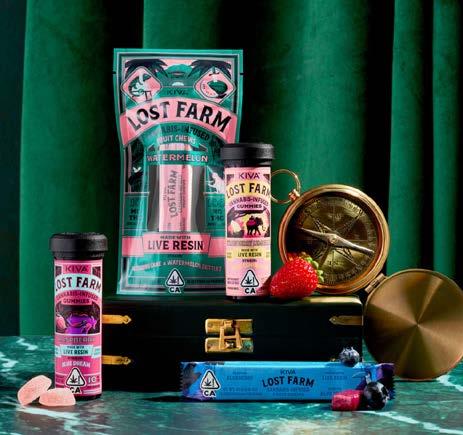

By contrast, there is a whole other segment of the consumer landscape holding on to what they see as positive aspects of isolation. They’ve come out on the other side of this crisis with new found passions, and as a result, they now spend more of their time and money on hobbies and personal development.
According to a UK study conducted by The Health Work Company, 22% of people in the UK took up a new pastime in lockdown, while 35% had rediscovered an old one. (Source: The Health Work Company)
At the height of the first lockdown last year, Google searches for terms like ‘online courses’ reached an historic high. Around that same time, LinkedIn reported that people watched over 3 times more video content on LinkedIn Learning in a week than before the pandemic. (Source: Forbes)
Now out of isolation, that desire for self-improvement hasn’t disappeared. Eager to reignite their social life off-screen, some consumers continue to prioritise products and experiences that come with an element of self-discovery or self-reflection. For them, pleasure now lies, at least partly, in the fulfilment of their own potential – in self-actualising.
22%
of people in the UK have taken up a new pastime during lockdown.
(Source: The Health Work Company)
Opportunity:
Put learning at the heart of your product experience. Create opportunities for consumers to hone their skills or acquire new ones. Facilitate them to learn from your brand, or from a collective sense of progress.
Example:
Usually specialising in live tours of London’s best chocolatiers, Chocolate Ecstasy Tours have been selling chocolate tasting kits with carefully curated chocolates from around the UK. Each kit comes with a tasting wheel and a guide to educate consumers.
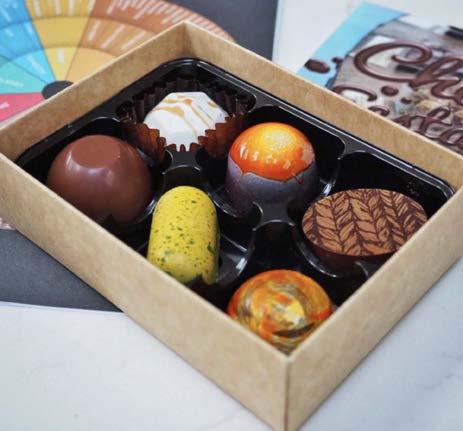 (Source: Chocolate Ecstacy Tours)
(Source: Chocolate Ecstacy Tours)
4 PLEASURE IN MODERATION

Recent events have made some consumers eager to take matters into their own hands. This is especially true in relation to their personal wellbeing – both mental and physical.
In the UK, news shows recorded their lowest ratings in 2020, as more people chose to stop following the news in order to protect their mental health (Source: BBC).
Across the globe, there was a surge in downloads of meditation apps. In fact, the Headspace app was downloaded 65m times in 2020; a record growth for them. (Source: TechCrunch)
As for physical wellbeing, consumers are taking control by reassessing their relationship with food and drink to establish what’s good for them and what’s not. In France, there has been a huge surge in demand at organic food shops, which reported sales growth of up to 40% last year. (Source: FMCG Gurus) They’ve learned to be the masters of their own cravings, and that how they feel is up to no one but themselves. Now, they seek less harmful ways to indulge, and are actively tapping into special ingredients as a way to boost their wellbeing. For them, pleasure comes from taking control.
Opportunity:
Provide consumers with the information they need to feel in control. Help them to make the right choices and indulge guilt-free. Tap into ingredients and products that provide physical and mental health benefits; allowing them to make considered choices, curate their consumption and put them in the driving seat of their desires.
Example:
Verywell Drops are water-soluble cannabis extracts that give consumers complete control over how they feel. All they need to do is to pick a drop that matches their desired mood and tweak the dosage accordingly.
CONSUMERS & OPPORTUNITIES
HEDONISTIC CONSUMER RESTRAINED CONSUMER 01 01
THE SERIOUS BUSINESS OF PLEASURE THE PLEASURE OF LEARNING
• Facilitate the consumer to escape from the real world.
• Consumption of your product should feel like the ultimate reward.
• Create opportunities for consumers to hone their skills or acquire new ones.
• Put self-improvement at the heart of your product experience.
In the UK, news shows recorded their lowest ratings in 2020, as more people chose to stop following the news in order to protect their mental health.
(Source: BBC)
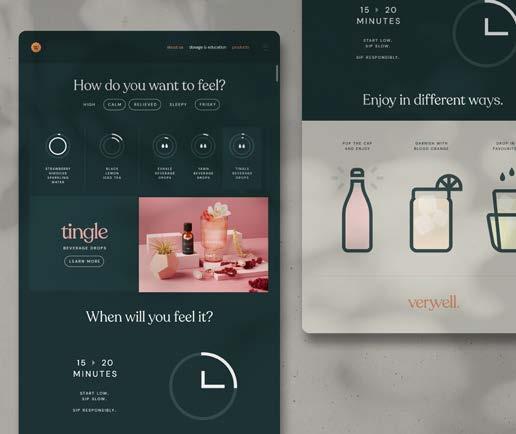
02 02
PLEASURE IN MODERATION ADVENTURES IN PLEASURE
• Encourage discovery.
• Create the excitement of newness by taking consumers out of their ordinary.
• Provide consumers with the information they need to feel in control.
• Facilitate them to make the right choices and indulge guilt-free.
2020 (Source:
Verywell)
MAKING LESS MEAN MORE
TURNING F&B RESTRICTION INTO OPPORTUNITY

We are in the middle of a health crisis. Not the COVID-19 pandemic, but an obesity crisis. In the UK, two thirds of all adults are overweight, and one third of those are obese. (Source: Sky News)
However, around the world, the scales are tipping in the wrong direction, and the COVID-19 pandemic added to that, as 9 in 10 deaths globally took place in countries with a high obesity rate. (Source: Sky News)
In the UK, the government is introducing a ban on HFSS (high-fat, salt and sugar) food advertising. Similar restrictions – albeit not as punitive are also being implemented in other countries, including Australia, Canada, France and Mexico.
Change is coming across the whole F&B category, and not just because of a change in government policy.
A major shift in consumer behaviour has been taking place for years. In fact, 51% of consumers claim to have switched ‘traditional’ snacks for high-protein or low-sugar ones in the last year. (Source: FMCG Gurus)
The same is true for alcoholic drinks. In the US, sales of non-alcoholic beer grew by 34.8% in 2020. (Source: Forbes)
If you already have a new better for you product in your pipeline, you may be wondering how you can position, package and communicate these line extensions. Fortunately, this is charted territory. No and low alcohol brands have been doing this for years.
Rather than seeing it as a negative, we see a lot of opportunity for brands to make ‘less’ – calories, alcohol, fat, sugar, salt – mean ‘more’:
In the US, sales of non-alcoholic beer grew by
34.8%
(Source: Forbes)
1 MORE VISIBILITY

As some media channels become off-limits, your ‘better for you’ products will become the new heroes. They will help to keep your brand salient, giving consumers something to talk about.
In the last two years, organic social media conversations about No-Lo beverages were up by 85%, whilst conversations about alcoholic beer were down by 23%.
(Source: Forbes)
And because there is always going to be appetite for indulgent treats – 64% of consumers globally believe it is okay to enjoy them as part of a balanced diet (Source: Nielsen). Your ‘better for you’ lines will take up the role of recruiters for the wider portfolio, spanning often conflicting consumer desires e.g. indulgence and wellbeing.
decrease in social media conversations for alcoholic beer.
85%
growth in organic social media conversations about no and low alcoholic beverages in the last 2 years.
(Source: Forbes) (Source: Forbes)
2 MORE CONSUMERS
Better for you variants can help brands become present in previously unimagined, new occasions.
Take the example of alcohol brands, which can now use NoLo brand extensions to access previously NoLo occasions. In fact, 20% of all non-alcoholic beers are sold as replacement to soft drinks, instead of alcoholic options. (Source: Wall Street Journal).
In the case of alcohol-free beer, the WHO estimates that the size of the market is equivalent to 57% of the world’s population. (Source: WHO)
So rather than seeing ‘better for you’ products in your portfolio as niche, look at the enormous potential to increase brand penetration. Lower fat, salt and sugar food products are not only more likely to come into the consideration list of consumers following strict diets, but they can be consumed with more frequency too.
The global alcohol-free beer market is a large and diverse market that accounts for
57%
of the world’s population.
(Source: WHO)
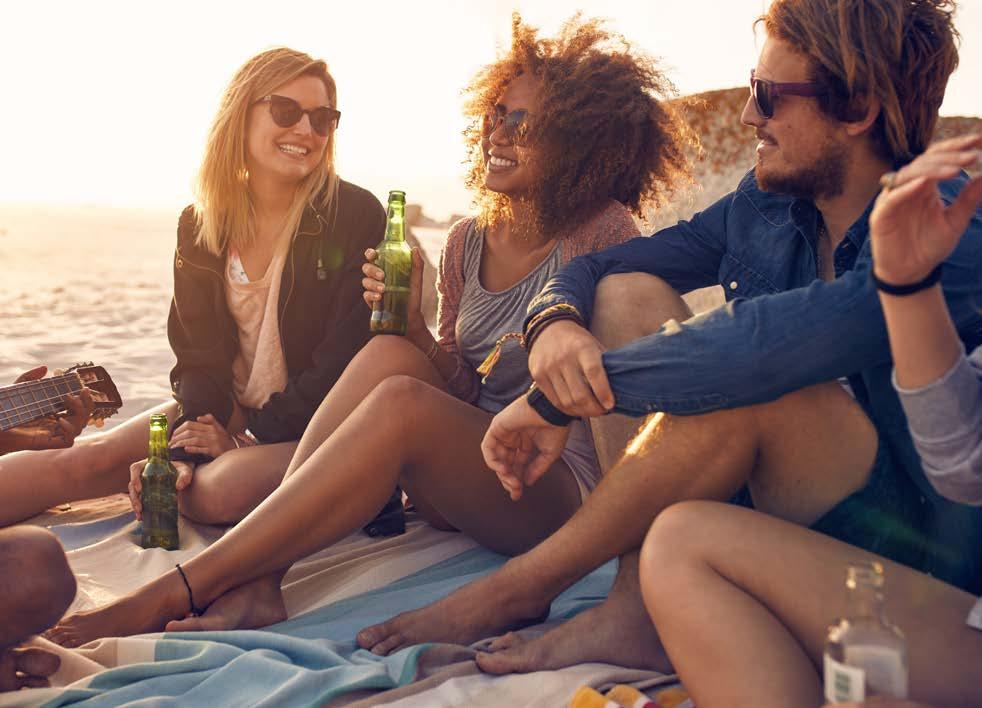
Technology and social media have enabled new, nimble brands in the ‘better for you’ sector to disrupt categories that were previously dominated by a few heavyweights.
One thing all of these ‘challengers’ have in common is an inherent ability to break the rules: playing with pre-established category codes and conventions, with an incredibly high level of social media fluency, and their focus tends to be on e-commerce.
A shift in consumer behaviour is also fuelling the playful nature of these brands. Younger generations are more willing to set themselves apart through the brands they buy, and see upand-coming brands as a tool to achieve that goal. Being ‘new kids on the block’, these brands are not bound by category codes and conventions, or by attributes like heritage and behaviour from the parent brand. But with new products in the pipeline, your brand has an opportunity to create impact as well.

3 MORE FUN
4 MORE PURPOSE MORE OCCASIONS
One of the biggest opportunities for alcohol brands when launching no and low product extensions is the possibility of making their brand present in previously unimagined occasions. In fact, 20% of all nonalcoholic beers are sold as replacement to soft drinks, instead of alcoholic options. (Source: Wall Street Journal)
From sponsorship deals with Formula One to pop-up experiences like fitness classes and drive-thru tasting stations, drinks brands can now target new and existing consumers in different places and occasions.
As a result, even sales of their standard alcoholic drinks are up. In the case of Heineken, by 8.3% in 2019; their best performance in over 10 years.
(Source: Yahoo Finance)
20%
of all non-alcoholic beers are sold as a replacement to soft drinks, instead of alcoholic options.
(Source: Wall Street Journal)
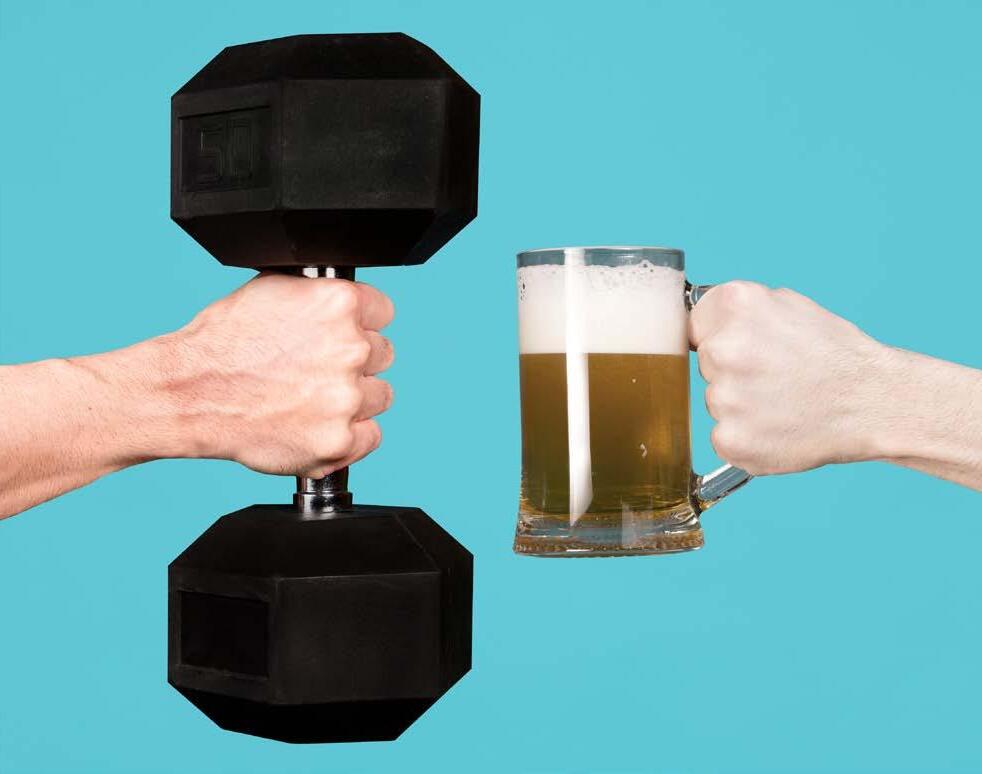
5

Your brand’s purpose and activism are good starting points when trying to find a message that can overcome the incoming channel barriers.
In fact, ‘purpose’ is already one of the main drivers of purchase for some consumers, in particular Gen Z and Millennials. 9 in 10 Gen Z consumers think brands have a responsibility to help address social and environmental issues. (Source: McKinsey)
A brand that understands this well and has leveraged brand purpose and activism to connect with young consumers is Ben & Jerry’s. They always manage to compellingly incorporate their products and messages into larger social movements to scale their communications.
As a result, Ben & Jerry’s is the #8 most loved food brand amongst 13-17 years old, despite them facing tight marketing restrictions. (Source: YPulse)
9 in 10
Gen Zers believe brands have a responsibility to address social and environmental issues.
(Source: McKinsey)

CHRISTIAN TORRES
WE CHECKED IN WITH GLOBAL BRAND LEAD AT TUI, TO EXPLORE THE FUTURE OF TRAVEL AND TOURISM AS THE WORLD RE-OPENS AND INTERNATIONAL TRIPS RESUME.

What is different about consumers habits and the way we travel now, vs pre COVID-19?
Obviously, the pandemic impacted the customer travel habits considerably – what we’re finding now is that people are looking for more in the way of flexibility and reassurance. That’s why we introduced things like our Holiday Promise and Covid Cover to help customers navigate the seemingly ever-changing landscape of government travel advice. What’s more, consumers are seeking out established brands they know and trust. And, of course, this is one of TUI’s brand strengths. It’s fair to say that the package holiday got trendy again and being part of an association like ABTA and the ATOL scheme really counts.
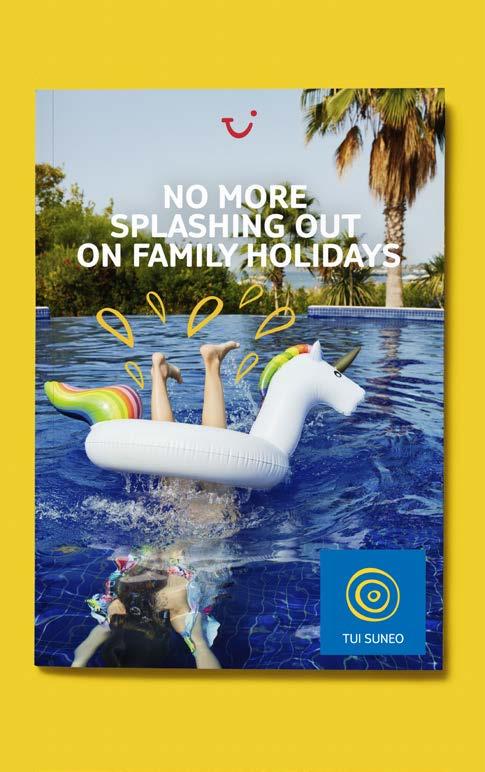
The pandemic triggered a huge staycation boom. How do you see this trend evolving now that international travel is returning?
“
How has TUI remained relevant and kept consumers engaged in a year without travel?
We took the decision to be ‘always on’ from a marketing point of view. When others decided to shelve their advertising spends, we were still out there, reminding customers they’re in a safe pair of hands with TUI. But we didn’t want all of our comms to be about the pandemic. Our team-up with Ant and Dec’s Saturday Night Takeaway, for example, saw us give out loads of free holidays. We put out a really fun advert at around the same time. It saw our colleagues get really inventive by mocking up their favourite holiday scenes at home – think ‘swimming’ in the bathtub and ‘skiing’ over sofa cushions. It was really well received by the public and inspired a similar customer-created campaign on social media. Most recently, our new ‘Live Happy’ global ad campaign has set out to remind customers about the sheer joy of travel – nothing compares to the excitement of booking a holiday and the life enrichment you get from new experiences.
Well, of course, with vast parts of the world in lockdown, lots of customers had no option but to look to home-grown getaways. Certainly, our continental overland driving holidays have been very popular with our holidaymakers who live in Germany, Belgium and the Netherlands etc. However, closer to home, the unpredictable British weather can put a real dampener on a trip. As such, since the world has reopened, we’re seeing a spike in overseas bookings with UK consumers –it’s clear to see that after a year of being stuck at home in Blighty, people are keen to head off to sunnier shores. After all, nothing compares to feeling the sun on your face and the sand between your toes. Whether staycations remain on trend is yet to be seen but what we’re really noticing is a demand for work-cations. It would seem the rise of Zoom and unshackling from offices means more and more people want to combine their work and leisure time. And who can blame them? Who wouldn’t want to tackle emails while looking out to sea? Sure beats the Monday morning commute!
Which destinations do you think will be the most popular in 2022 and why?
European favourites, like Spain, Greece, Portugal, Italy and Croatia, are proving really popular. I think it’s probably got something to do with the proximity to home as people start to venture beyond the UK again. That said, as long-haul routes come back onto our books, we’re seeing real demand for places like Mexico, the Caribbean, Thailand and Vietnam. My personal predictions? Keep an eye on places like Senegal and Zanzibar. What with talk of inflation looming, these up-and-coming destinations will give consumers more bang for their buck.
“ Whether staycations remain on trend is yet to be seen but what we’re really noticing is a demand for work-cations.
What impact do you think our growing awareness of sustainability will have on travel in the future?
Sustainability is key to any travel brand worth its salt – and at TUI it’s part of our DNA. That’s why we’re constantly investing in cutting-edge, greener aircraft, like Dreamliners and the new 737s, and more and more of our hotels are signing up to our sustainability pledges which cover everything from installing solar panels through to chefs cultivating their own ingredients in hotel grounds. But reducing carbon footprints is only part of the picture. It’s also about getting the message out regarding the positive effects of tourism. After all, for many people travel is their livelihood – whether that’s working in a hotel, operating excursions, running local bars and restaurants etc. And that’s where the TUI Care Foundation comes in. Our charity makes a real difference by creating lasting impacts on the people and places we operate to around the world. There are all sorts of initiatives. Some are ‘of the moment’, like our Corona Relief Fund and our La Palma Emergency Relief Appeal. Others are more long-term, like our Turtle Aid and Elephant Aid programmes. But many see us helping with economic development by promoting entrepreneurship in local communities. In Morocco, for example we’ve helped a startup train up nearly 100 young Moroccans as bike tour guides or bike mechanics. In Lanzarote, meanwhile, we’re supporting projects to preserve traditional winemaking techniques. And that’s just the tip of the iceberg. Yep, it’s fair to say that sustainability is set to become an increasingly major factor in the world of travel.

AVIÓN TEQUILA
Creating elevated experiences at iconic beach club destinations.
Avión initially had a tough time convincing consumers they were a real product after launching on the hit TV show Entourage. However, once they started getting liquid on lips, they’ve since gone from strength zto strength.
As part of their ongoing growth strategy, we were asked to create a suite of highly-visible, super premium, yet easy to execute serve rituals.
As the world re-opened and a significant part of society wanted to escape from the worries and responsibilities of the real world to indulge in a world of pleasure, beach clubs were the perfect destination for building brand awareness with their target consumers “experience collectors”.
All centred on the brand platform of ‘Tequila. Elevated’, we developed drinks serve tools, bar takeover assets, bar to table rituals, staff uniforms and photo moments for both the core range of tequilas, and Reserva 44, their 44-month aged liquid.
OUR INVOLVEMENT:
Serve Rituals
POS Design

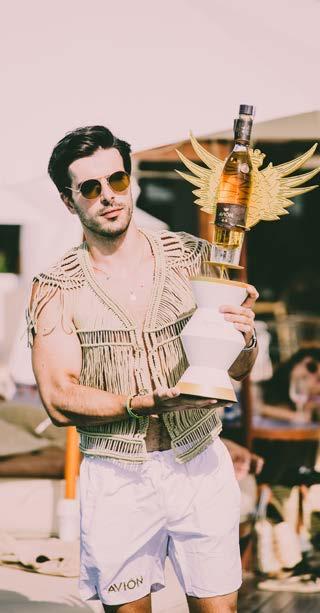
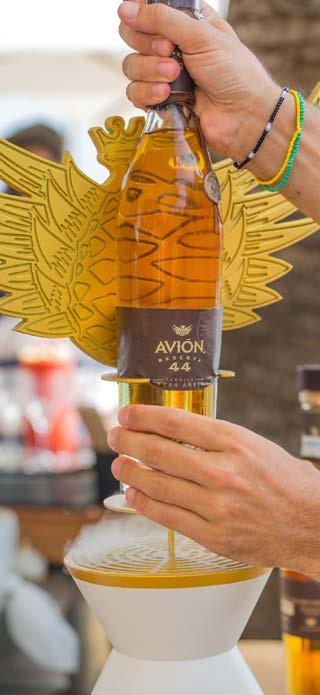

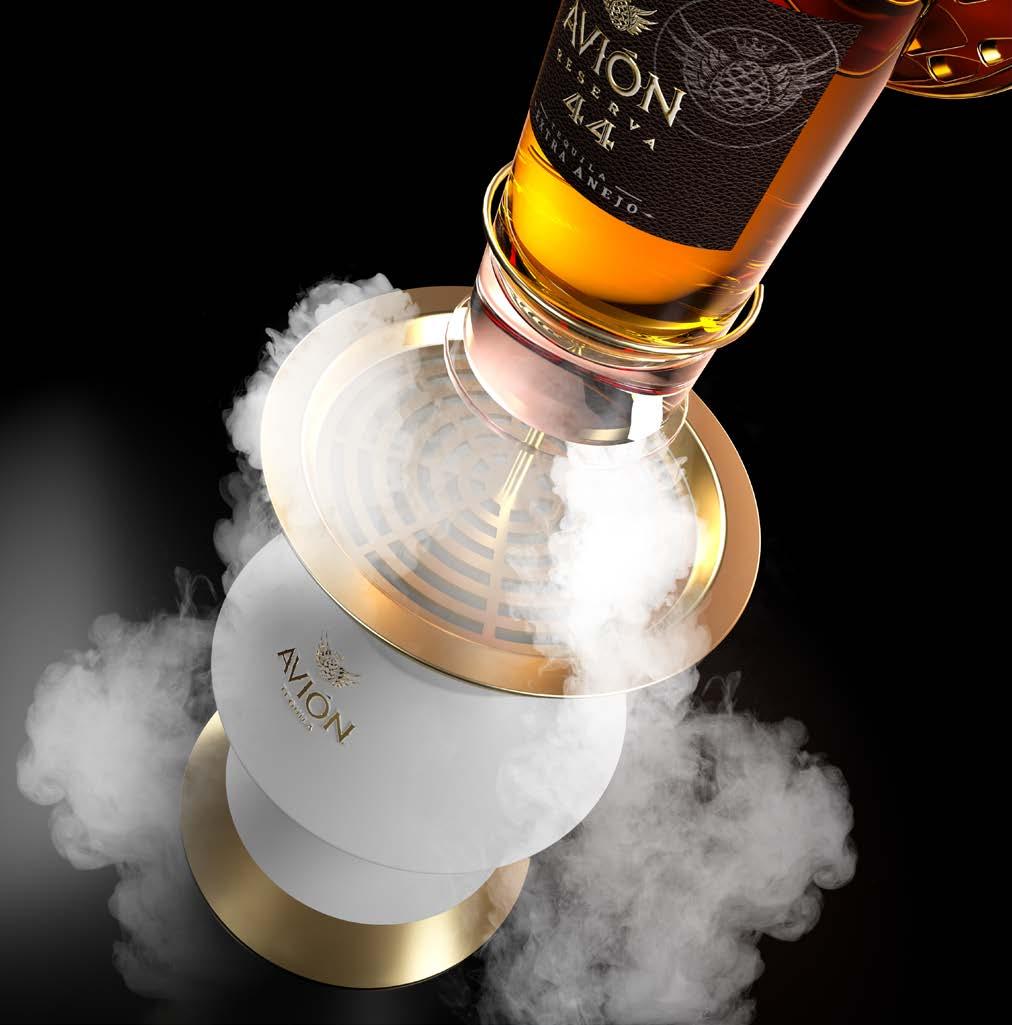
The design language took inspiration from modern Mexican furniture, and the designs were elevated through high end materials and finishes, to bring the brands super-premium credentials to life.
From simple yet effective levitating shaker illusions, to glorifiers where the bottle appears to float, the toolkit provided a variety of scalable options for the different markets to activate.
The activations have been rolled out in iconic beach destinations across the Mediterranean such as Ibiza and are soon to be featured in more global destinations.
SHOW ME IBIZA
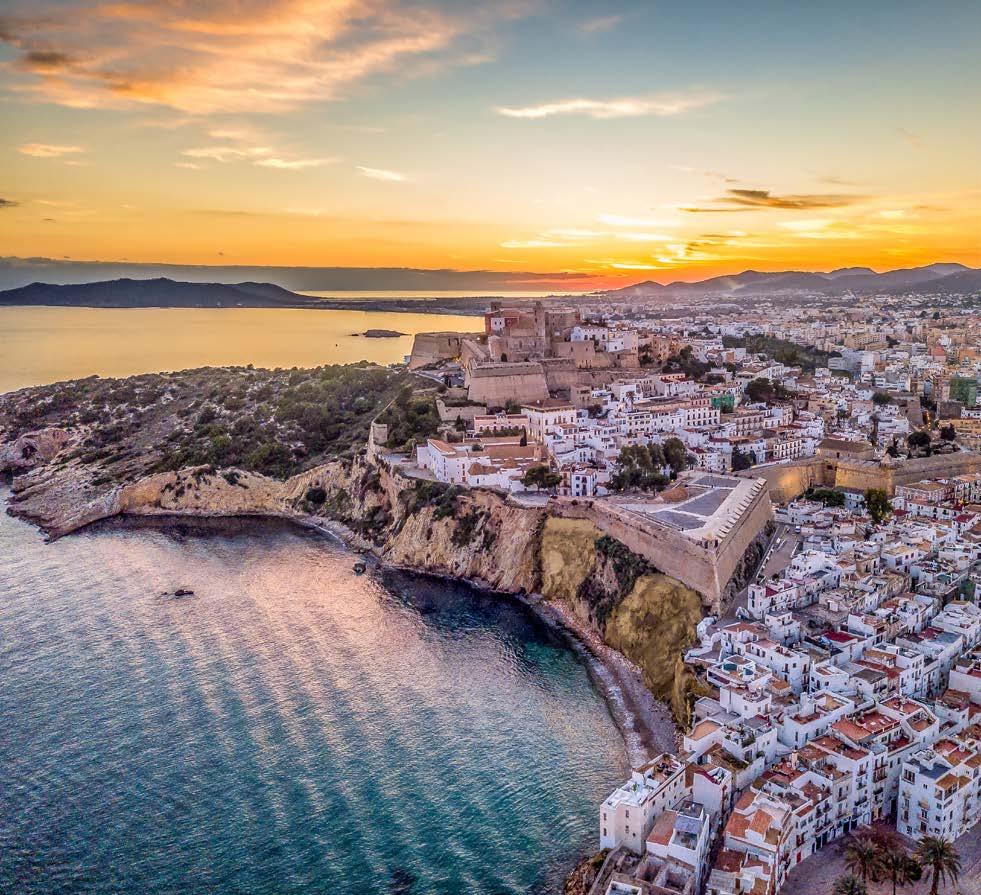

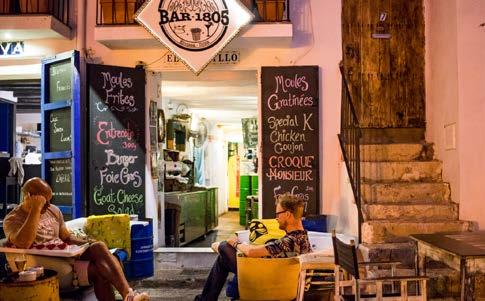

INDULGENCE ON THE WHITE ISLE
1. Café Bondi
Combine Bondi with Brunch and you arrive at Café Bondi. With scenic views overlooking the harbour, kick off your day here by tucking into an organic breakfast or brunch, washed down with a refreshing smoothie, mocktail or cocktail to begin your perfect day on the island.
2. Blue Marlin
Once you’re ready to catch some rays, head over to the shores of the south coast Cala Jondal, to Blue Marlin which brings together everything Ibiza is well known for –beats, beaches, and booze.
Here you can soak up the sun against the waves of the sea, followed by a spot of lunch on the terrace, for the ultimate day of relaxation.
3. Café Mambo
After a hard day’s work, lounging around at the beach club you’ll want to head to the heart of San Antonio to Ibiza’s most iconic sunset bar. Hosting world-class international DJ’s - Pete Tong, Carl Cox, and Eric Prydz, you’re in the hot seat to enjoy the sounds of summer, as another day on the white isle ends and the night begins.
4. Bar 1805
As the day turns to dark, it’s time to head into Ibiza Town as drinks here are sure to be served with ‘joie de vivre’ - the enjoyment of life. Owned by the highly awarded ‘World’s Best Mixologist’, Frenchman Charles Vexenat is the mastermind behind the bar, where you can get the party started with a cocktail list full of unique flavour combinations.
5. Glitterbox, Hi Ibiza
Last but not least, It’s 1am and it’s the beginning of the end. Described as a party where ‘everyone smiles, hugs and throws their hands in the air’, end your night on a high at Glitterbox. With a mixture of new and old music, it’s a guilty pleasure for all partygoers on the island, before the sun comes up and it’s time to sleep, eat, rave and repeat.











 (Source: Chocolate Ecstacy Tours)
(Source: Chocolate Ecstacy Tours)




















